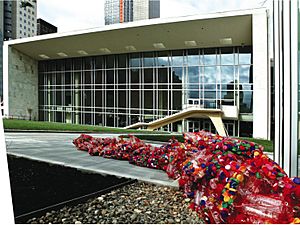North Atlantic garbage patch facts for kids

The North Atlantic garbage patch is a huge area in the Atlantic Ocean where lots of human-made trash floats. It's a type of garbage patch made of marine debris, which means rubbish found in the sea. This patch was first noticed in 1972. It floats inside a giant ocean current system called the North Atlantic Gyre.
Scientists from the Sea Education Association studied this patch for 22 years. They believe it is hundreds of kilometers wide. It can have over 200,000 pieces of trash in just one square kilometer. Most of this trash comes from human waste that travels from rivers into the ocean. It is mainly made up of tiny plastic pieces called microplastics.
This garbage patch is very dangerous for ocean animals and even for humans. Animals can eat the plastic or get tangled in it. Not many groups have worked to clean up the North Atlantic garbage patch. Most efforts have focused on the Great Pacific garbage patch, which is a similar area in the Pacific Ocean.
Contents
What is the North Atlantic Garbage Patch Like?
Where is the Garbage Patch Located?
The North Atlantic garbage patch is found between 22°N and 38°N latitude. Its exact western and eastern edges are not clear. The area where the trash collects can move a lot. It shifts about 1,600 kilometers (990 miles) north and south depending on the season. It drifts even further south during an El Niño event. This information comes from the National Oceanic and Atmospheric Administration (NOAA).
Scientists estimate the patch is hundreds of kilometers wide. It has a high density of trash, with over 200,000 pieces per square kilometer. This means there's about one piece of plastic for every five square meters. Even though the world makes five times more plastic now, the amount of plastic in the North Atlantic garbage patch has stayed about the same. This might be because some plastics sink or break down into pieces too small to be seen.
Where Does the Trash Come From?
The North Atlantic garbage patch forms from human waste. This trash travels from rivers on land and flows into the ocean. Once in the ocean, it gets pulled together by giant swirling currents called gyres. These gyres collect the trash into large floating masses.
Most of the trash floating on the surface of the patch is microplastics. These tiny pieces come from common household items. They are often made of plastics like polyethylene and polypropylene. Scientists think that heavier plastics might be under the surface. These include plastics like polyethylene terephthalate, which is used for water bottles. However, current ways of collecting samples only catch the tiny plastics floating on top.
How Do Scientists Study the Patch?
A big study was done by the Sea Education Association, Woods Hole Oceanographic Institution, and the University of Hawaii at Manoa. They collected plastic samples in the western North Atlantic and Caribbean Sea from 1986 to 2008. Over 7,000 students helped with this research.
They used special nets called surface plankton nets to pull through the water. Over 22 years, they did more than 6,136 net pulls. They found over 64,000 pieces of plastic. Most of these pieces were tiny, less than 10 millimeters in size.
A scientist named Nikolai Maximenko from the University of Hawaii created a computer model. This model helps explain how plastics gather in garbage patches. It uses information from over 1,600 drifting buoys tracked by satellites. These buoys help map out the ocean currents. The plastic data collected by the students helped prove Maximenko's model was correct. This allowed researchers to successfully guess where plastic would build up in the North Atlantic Ocean.
What is Being Done About the Garbage Patch?

Not many efforts have been made to clean up the North Atlantic garbage patch. Removing the tiny plastic pieces, or microplastics, could harm other small ocean creatures. These creatures might also get filtered out during a cleanup.
To raise awareness, artist Maria Cristina Finucci started "The Garbage Patch State" on April 11, 2013. This happened at UNESCO in Paris. This project was the first of many events to bring attention to the problem. It led to art shows around the world. These shows helped people understand how big and serious the garbage patches are. They encouraged people to take action.
A Dutch inventor named Boyan Slat started a non-profit group called The Ocean Cleanup. This group is creating new technologies to remove plastic from the oceans. They plan to start cleaning the Great Pacific Garbage Patch first. Later, they hope to clean other garbage patches around the world. Besides cleaning ocean microplastics, The Ocean Cleanup is also working on ways to remove larger plastic pieces from rivers. Rivers are a major source of plastic flowing into the ocean.
See also
 In Spanish: Mancha de basura del Atlántico Norte para niños
In Spanish: Mancha de basura del Atlántico Norte para niños

